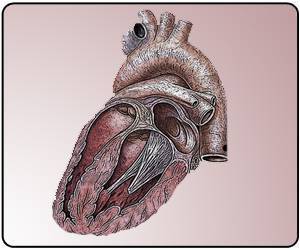The largest study of gender differences reveals that women with severe aortic stenosis are 40% less likely to die after transcatheter aortic valve implantation (TAVI) than men.

More than 1.5 million people in the US suffer from aortic stenosis, a progressive disease where the aortic valve becomes obstructed, leading to life-threatening heart problems. If left untreated, half of all patients do not survive for more than two years after the initial onset of symptoms. Traditionally, treatment involves open heart surgery to replace the diseased valve; however in frail and elderly patients the surgery is highly risky and sometimes simply not possible to perform.
A groundbreaking non-surgical treatment, known as transcatheter aortic valve implantation (TAVI), has shown considerable promise in these high-risk patients. Pioneered in Canada in 2005 by interventional cardiologist Dr John Webb and his team at St. Paul's Hospital in Vancouver, the TAVI procedure is minimally invasive and does not require major surgery.
Since the first successful valve implantation by Dr Alain Cribier from France, more than 50,000 procedures have been performed worldwide. To study the efficacy of the technique, researchers from the pivotal randomized trial, Placement of Aortic Transcatheter Valves (PARTNER) A, compared TAVI to traditional surgery and demonstrated patients did just as well with either procedure.
"The PARTNER trial also sparked considerable interest in gender differences," said Professor Humphries. "Women, at one year, were found to have lower mortality with TAVI when compared to men (1). However, the trial did not adjust for potential baseline differences between women and men. The US Food and Drug Administration's Circulatory Systems Devices Panel for the PARTNER trial has requested additional data on gender and longer-term results."
"Recent publications have sought to elucidate these gender differences in TAVI outcomes but have shown limited and conflicting results," she added. "A single centre study of 305 high-risk patients undergoing TAVI found no gender difference in 30-day mortality (2), while another study of 260 consecutive TAVI patients reported better 1-year survival in women, but failed to adjust for baseline differences (3)."
Advertisement
For this study, data from 641 consecutive, high-risk patients (51.3% women) with severe aortic stenosis undergoing TAVI between January 2005 and September 2011 were prospectively captured. Patients were followed for up to 2 years, with mortality as the primary outcome.
Advertisement
At baseline, women and men in the study population were of similar age, had similar aortic valve size in relation to their body size, and had similar extent of heart failure. Women had higher pressures across their aortic valve and worse kidney function but better ejection fractions. Men had more comorbidities such as prior heart attacks, prior revascularization, and chronic obstructive pulmonary disease (COPD).
After TAVI, women were more likely than men to experience serious procedural complications (12.4% vs. 5.4%) and major bleeds (21.6% vs. 15.8%). Yet, despite these adverse events, mortality remained lower in women at 30 days (6.5% vs. 11.2%).
Professor Humphries said: "We made extensive adjustments for demographic, procedural, and clinical differences between women and men to try and explain the observed gender difference. However, the female advantage persisted over the follow-up period with a hazard ratio of 0.60; meaning women were 40% less likely to die after receiving the treatment than men."
"Historically men have done better than women in almost all cardiac procedures," said Professor Humphries. "But for the first time, our study has shown women seem to benefit more than men after TAVI."
She added: "The results of the study, when considered in context of the PARTNER A trial findings, suggest TAVI might be the preferred mode of treatment in elderly women with symptomatic severe aortic stenosis."
Source-Eurekalert








